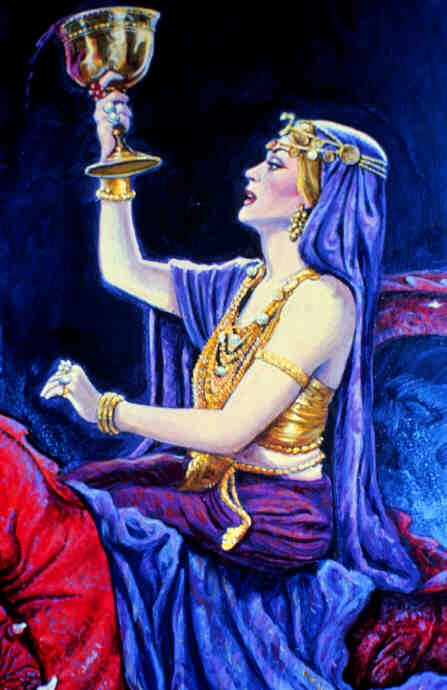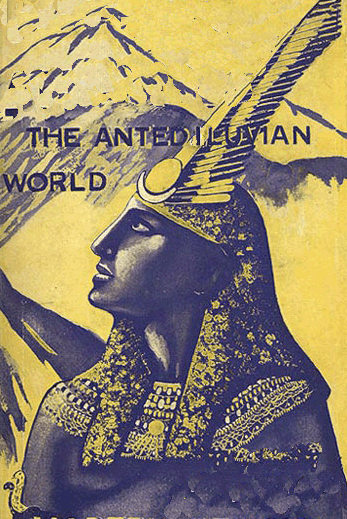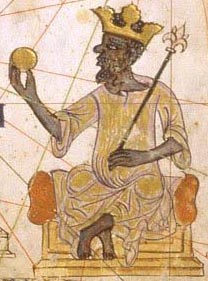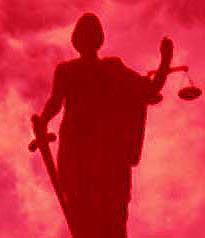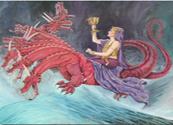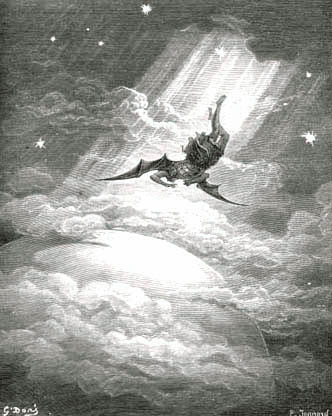Nimrod:
Father of The
Mother of Harlots
The mother of harlots as depicted in Revelation seventeen and eighteen is a composite of apostate Christian denominations, as well as other world religions, which are being led and directed by the oldest, and most powerful daughter of Mystery Babylon‑Roman Catholicism. But in the interest of fairness and truth we must point out that Mystery Babylon’s roots run much too deep to be considered as running only the course of the Christian Era. Mystery Babylon cannot, therefore, be considered the sole invention of Roman Catholicism, or any Christian denomination, or any disconnected heretical movement swirling around Christianity at any time during the present era. One of the titles given her in Revelation 17.5 is "The Mother of Harlots". The Catholic Church was not yet conceived when the mystery rites of ancient Babylon began to first pollute the world, therefore she could not have been its mother or the mother of all harlots. She, then, must be reckoned as simply one of the harlots of Mystery Babylon. In fact, we have stated that false religion, and therefore Mystery Babylon's foundations, were laid as early as the Garden of Eden and gained momentum with the ensuing great Satanic conspiracy of the fallen angels of the Antediluvian Era which nearly provoked God into destroying the entire human race. From passages in Genesis six we understood that some of the fallen angels had left their first estate in heaven and had taken on the likeness of human flesh so they could cohabit with the daughters of men and create a dominant race of half‑man, half‑god supermen who would rule on earth as "gods". As studies in comparative religion show, a system of false religion was established world‑wide. This worship of various gods and their connection with fertility rites and the worship of the elements of heaven and earth, like the sun, moon, water and fire spread and became more than just a way of life in the Antediluvian world. It became the way of worship for all mankind. In the sixteen centuries from Adam's creation to the Flood polytheism completely supplanted the true worship of the one true God.
This abhorrent religion was at the heart of the general evil and corruption into which the Antediluvian world had sunk. The "gods" that were born out of these unholy unions, along with their mothers and their "heavenly" fathers, competed for power with the other "trinities" of their same nature. Thus Genesis says that God looked on the situation and declared that, "The earth was corrupt before God, and the earth was filled with violence." These giant tyrants, or Nephilim, as the Hebrew word implies about them, were the real and living versions of what the mythological religions of Rome and Greece would enshrine and deify in the era just before Christ's first coming. Pagan religions of all cultures and civilizations adopted the same legends and myths from those former days when supernatural mortals, all of whom were destroyed by the Flood, ruled the earth and commanded the worship of their subjects. The kingdoms and cities of these half‑breed monsters were washed away by the Flood with little or no trace, but the stories and the accompanying legends that grew into overblown fables about these "gods" and their exploits were not lost to posterity. They would be carried into the new world of the post‑Flood Era by, of all people, Noah's own son, Ham, and his son, Cush. But it would be Ham's grandson that would resurrect the old false religion of Antediluvian days. He would greatly refine it so as to enshrine himself, set up a false trinity with him as god and savior, and generate a system of mystery rites and sacraments that would be the basis for "Mystery Babylon" in all ages to come. Like a chameleon this system would be adaptable to the vain imagining of man, able to suit the customs and needs of any people anywhere. Noah's great grandson, and the originator of this antichrist religion, of course, is the first of the Antichrist types found in Scripture, the infamous Nimrod.
Nimrod: Father of the Mother of Harlots
Fables and legends abound about this ignoble figure, called in the Hebrew tongue, Nimrod, and known universally (though by different names and identities) throughout the many and varied religions of the ancient world. An in-depth consideration of the information in the Bible shows that more than any other single person or thing, with the exception of Satan himself, this man was responsible for the religious system called, Mystery Babylon. This system was caste by his legendary life and his open rebellion against God and was further developed by his wife, Semiramis, and her priests after his decease. It was received by their adoring followers and at points during history, through the mediums of conquest, immigration, trade and slavery, found its way into the heart of the religion of every society of peoples on earth.
Upon the dispersion of the people by God at the Tower of Babel (Genesis 11) the religion of Nimrod was weakened, but by no means was it dissolved. Many of its devotees took it to their new place of abode after they were scattered from the city of Babel. Nimrod was still the object of worship (though he became known by different names because the language of the people had been diversified). The legend, the mystery rites, and the religious worship remained essentially the same. Everywhere Nimrod's fellow rebels went they took the religion of Nimrod with them and with it the power to rule over men’s hearts and establish the thrones of kings. Monarchs took the throne because they were descendants of the gods, Nimrod had set the precedent. The age-old right of the oriental potentate to sit upon the throne, the ruling power of Egyptian Pharaohs, and even the authority of the modern monarchs of Europe have depended upon the consent of the various ruling class of mystery priests, bishops or Pope who alone had the heavenly mandate to confirm and anoint kings. As Nimrod’s religion had established very early, they ruled by divine right because they had the blue blood of the gods running through their veins. Thus Mystery Babylon was born and her power solidified and protracted throughout the earth. As Revelation points out, Mystery Babylon is she who "reigns over the kings of the earth" (Rev. 17.18).
The Bible is brief, but concise, in telling us how the legend of this notorious evil doer got started. Genesis ten says Nimrod became strong in the earth and was a mighty hunter, the world’s first great builder of cities. In chapter eleven we are informed of a great spiritual crisis which was brought about by the force of this one man’s ego, pride and rebellion. The provocation took place in the capital city of his newly formed empire, Babel, and culminated in the incident commonly known as the “Tower of Babel”. This rebellion was so great and posed such a threat to the plan of salvation that it required God to take drastic action. The future of the entire human race was in jeopardy of being taken down a path of destruction and total annihilation, much like that of the judgment that took place before the Flood. The purpose of Mystery Babylon was to turn the hearts of the people away from God and to give them faith and trust in themselves. Nimrod gave the people what they wanted; a chance to throw off the "yoke" of God’s requirements of righteousness, and make conditions of worship more suited for their pernicious ways. Essentially, as false religion aptly does, Nimrod gave the people what they wanted; an escape from following God. The god he invented allowed for carnal lusts and earthly greed. The god of their invention would tolerate their sins and violence, and would permit them to live life as they pleased, chasing the lusts of the flesh, the deceitfulness of riches and the pride of life without regard for their fellow man, their true Creator, or the promise of the "Coming Savior".
Nimrod: The First King, EVIL Rebel
"And Cush begat Nimrod: he began to be a mighty one in the earth. He was a mighty hunter before the LORD: wherefore it is said, Even as Nimrod the mighty hunter before the LORD. And the beginning of his kingdom was Babel, and Erech, and Accad, and Calneh, in the land of Shinar. Out of that land went forth Asshur, and builded Nineveh, and the city Rehoboth, and Calah, And Resen between Nineveh and Calah: the same is a great city." (Gen. 10.8‑12)
As we can see from the above verses, Nimrod was the son of Cush and the grandson of Ham. Ham was the son of Noah who was cursed for his rebellious mocking of his righteous father (Gen. 9) and Cush, following in the footsteps of his father, became the leader and false prophet of the corrupt ways that were brought over the expanse of the Flood by Ham. There are ancient stories that credit Cush with grooming Nimrod to be the world's first king and the standard bearer for the rebellion against God. Nimrod was the founder of Babel and the architect of a chain of cities which he forged into the world's first great empire. Through written historical records and first- hand accounts about Nimrod, his wife and child do not exist; but his existence and career as mentioned in the Bible is not hard to verify. There is agreement among classical historians of all ages about Nimrod’s kingdom and that he and his system, in substance, are the basis for all mystery rites of subsequent mystery religions in all cultures. Ancient historians like Hesiod, Herodotus, Homer and Epiphanius, through Christ’s contemporary, Josephus, up to Maimonides, the great Jewish Rabbi of medieval times, accept the basic facts about Nimrod and his kingdom. Modern archeology supports the Bible record on Nimrod. The work of nineteenth century archeologists, Paul Emile Botta, Henry Austen Layard, and scholars like Sir Richard Wilkinson, George Rawlinson and Rev. Alexander Hislop, help to establish that Nimrod’s empire was the first empire formed and that it was in the region of present day Iraq, known in early times as Chaldea and Babylon. These men traversed deserts, hazarded storms, waded through ancient manuscripts and documents, fought hostile tribes and risked their lives traveling through inhospitable lands to piece together ancient historical facts that support the saga of Nimrod and the conspiracy in the land between the Tigris and Euphrates Rivers as related in Genesis ten. For the most part all of these historical accounts agree, and though speculations on some of the traditions and legends surrounding Nimrod may differ, the consent is unanimous that this man was the innovator of many corrupt things on the earth after the Flood.
He was the first builder of cities after the Flood , the first one to hunt prey from horseback, first to tame wild beasts, first to enslave men, first to utilize forced labor for building projects, first to conscript men into military service, first to rule a kingdom by force through a standing army, first to fortify cities, first to wear a crown, first to demand loyalty and worship from subjects, first man to rule a nation as supreme king and lord of all, and first to declare himself god on earth. With these precedents the earth had a foundation for man to acquire and reacquire pagan religion. Nimrod's Babel is the common source of false religion. Though shrouded in different names, with different dialects, languages and words, they provided essentially the same prescription for worship.
As the fine scholar and author of Two Babylons, Alexander Hislop notes the name Nimrod is rendered from Nimr, meaning rebel, and rod, meaning leopard. Therefore it can be interpreted as rebel leopard, and usually is by most commentators. This meaning is certainly justified because, as we see in chapter eleven Nimrod was the leader of the great rebellion against God that took place at Babel in the building of the tower and the gathering of the people there into one unified group against God. But Hislop gives us a better rendering with more insight. He says the name is best interpreted as "leopard subduer". And this, according to Hislop is the character of the man that is being described in chapter ten verses 8‑9.
Nimrod: Hunter and Horseman
Among the ancients (Ovid, Homer, Hesiod, Herodotus), Nimrod was purported to be the first man to break horses and use them in the hunt. The Bible declares that he became a "mighty hunter before the Lord". At the time of Moses' writing of the book of Genesis, Nimrod and his prowess as a hunter remained a proverb in the earth, "Wherefore it is said, Even as Nimrod the mighty hunter before the Lord." But Nimrod apparently also employed the leopard, as it continued to be right up until modern times, as a means to hunt other animals. In India, Africa and the Middle East the leopard still symbolizes lordship and power. Even today many leaders on these continents don leopard skin hats as a sign of their royalty and ruling dignity. Nimrod was the source of this tradition. He tamed the leopard and used it to chase down his quarry. He became a symbol to all the world, after the Flood, of man's capability to subdue the earth. He is also the Emancipator or Deliverer as some of his names under his "godhead" suggest and proclaim. His deliverance was not, however, from sin but rather from the yoke of God. Reverend Hislop tells of a folktale of Hindi origin that speaks of man having to walk hunched over because the heavens were too close to the earth. A mighty deliverer, however, came to the rescue for mankind when he pushed the heavens away from the earth in three separate stages allowing mankind to walk upright without being oppressed and weighed down by the closeness of the heavens. This story is an indication that men felt the presence of God was an intrusion and a burden. It was Nimrod who threw off the unwelcome presence of the Creator and gave them a supposedly less oppressive “god” (himself) to worship.
Hislop further points out that the title of being a mighty hunter before the Lord suggests that Nimrod even hunted men. He subdued villages and communities and forced them into his cause. It can hardly be questioned that Nimrod was a rebel, even the root of his name is connected to rebellion, but he was also a subduer of men. The Bible tells us that, once Nimrod had gained a name for himself and the strength to enslave men, he and his army of men started westward from regions east of the land of the Tigris River (probably from a place like the plush land of Elam, southeast of the Tigris River along the northern tip of the Persian Gulf) until he and his subjects came to the area called Shinar in the Bible. Once in this garden spot they began to build cities, including the fabled city of Babel. The saga of the Tower of Babel is one rife with suggestion of rebellion against God. It is obvious that the ringleader of this rebellion was the man named in the Bible as the builder of fortified cities along the fertile stretches of the Tigris and Euphrates Rivers.
They came together to defy God
"And the whole earth was of one language, and of one speech. And it came to pass, as they journeyed from the east, that they found a plain in the land of Shinar; and they dwelt there. And they said one to another, Go to, let us make brick, and burn them thoroughly. And they had brick for stone, and slime had they for mortar. And they said, Go to, let us build us a city and a tower, whose top may reach unto heaven; and let us make us a name, lest we be scattered abroad upon the face of the whole earth. And the LORD came down to see the city and the tower, which the children of men builded. And the LORD said, Behold, the people is one, and they have all one language; and this they begin to do: and now nothing will be restrained from them, which they have imagined to do. Go to, let us go down, and there confound their language, that they may not understand one another's speech. So the LORD scattered them abroad from thence upon the face of all the earth: and they left off to build the city. Therefore is the name of it called Babel; because the LORD did there confound the language of all the earth: and from thence did the LORD scatter them abroad upon the face of all the earth."
(Gen. 11.1‑9)
God's first command to Noah and his three sons was "to go forth and replenish the earth". Genesis 9.18‑19 tells us,
"And the sons of Noah, that went forth of the ark, were Shem, and Ham, and Japheth: and Ham is the father of Canaan. These are the three sons of Noah: and of them was the whole earth overspread."
The command was that they should scatter over the face of the earth to repopulate it. Genesis ten records the genealogies of the three sons of Noah and tells where they settled. God had cleansed the world of the corrupt and violent seeds of the Nephilim by water, but it did not take man long to rebel against God's expressed wish that they should scatter over the face of the earth, even in this new cleansed world. Instead they clumped together and conspired against God. There are many implications to be gleaned from the brief but concise accounts of Genesis given about Nimrod's sedition. When considering these crimes in the context of their time we can easily see the precedent that was laid for all false religion and for those abominable practices that followed in their wake, and that these abominations continue even to this day though in somewhat different form. In Genesis, five primary things are revealed about the people and the condition of the world at the time of the conspiracy at Babel.
1. The whole earth was of one language.
2. They came from the east and found a place to perpetuate their rebellion.
3. They used bricks and mortar to build their tower and city
4. They wanted to make a name for themselves so they would not be scattered over the earth.
5. When the people acted as one, nothing they could imagine to do could be restrained from them.
It must have been a terrible thing they were conspiring to do if God had to take such drastic action as to confound their ability to communicate with one another and to drive them into separate corners of the earth. But when we put together all of the components that are revealed in Genesis eleven we see why God did what He did.
The people must have been of one mind and one spirit in order for them to build a fortified place where they could plant themselves, be safe and not have to scatter over the face of the earth as God had commanded them to do. Remember, Nimrod was only two generations removed from the Flood. Ham was his grandfather. Men of his generation lived four hundred years. Shem was still alive. Nimrod and his followers knew full well that God had commanded every one to live under patriarchal authority in small communities and to scatter across the whole earth. But Nimrod's people came to the plains of Shinar for the expressed purpose of coming together. They left their homes in defiance of God. They built a fortress (many of the gods of false religion have "fortress" as part of their name and focus of worship) with “the bricks of rebellion” and “the slime of unity”. The first thing that Noah had done when he left the ark was to offer sacrifice to God. It was well established that man was to rely on and trust in God for everything. Noah's obedience was an undeniable living testimony to this great fact of faith. But Nimrod and his followers gathered together for the exact opposite reason: so they would not have to rely on God. They fortified themselves against wild beasts and marauding bandits and tried to become totally self-reliant so they could disregard the necessity of relying on God their Creator.
The Scripture also says that they wanted to make a name for themselves so they would not be scattered abroad over the face of the earth. Hislop believes that this idea of making a name for themselves had less to do with fame (although that was part of it) as it was connected with living by names and signs, especially the signs of the Zodiac. Ben Adams in his book, Astrology, The Ancient Conspiracy, makes the same point, as does E.W. Bullinger in his book Witness of The Stars. They all agree that the mention of the Tower reaching to heaven in the King James Version would more properly be rendered as, "depicting" the heavens. Even Herodotus, the Greek historian who saw the tower after it was finished by Nebuchadnezzar, confirms this interpretation. He reported in the fourth century B.C. that the Tower of Babel had the twelve signs of the Zodiac brightly painted in twelve startling colors around its seventh and final level. It is probable that they were trying to make a name for themselves, but it was the name of the god of their own invention, and it was certainly with the man in charge: Nimrod. They had settled in the plains of Shinar, the garden place of the world, plush and fruitful in wheat, dates and figs, to carve out their own “island” paradise without God’s approval and with His exclusion. They wanted to have someone to worship other than God and Nimrod was their man. As Bullinger and Adams so deftly prove, the stars in the sky foretold the coming of the Savior. God had put them there and explained their meaning to Adam. Adam in turn, handed them down orally, before the written word was invented, to Seth, Seth told Enoch, and so on. In this way the salvation story was known and understood by early man, including Nimrod and his followers. Even the riddle of the Sphinx, the colossal statue with the head of a woman and the body of a lion, is revealed when we understand the witness of the stars. In the circle of the stars in heaven the Sphinx tells man where the story begins. To understand its meaning we begin with the constellation Virgo, the promise that the seed of the woman would redeem the earth, and end with Leo, Jesus Christ coming back as the Lion of the tribe of Judah. The ten constellations in between tell of the birth, life, ministry, death, resurrection, ascension and separated ones of the Messiah.
The name that the people were going to “make” was by means of attributing all of these prophecies of the coming Savior to Nimrod, his wife, Semiramis, his son Tammuz - and themselves as their followers. Nimrod intended to lift himself up as the Messiah and exalted himself as the one who could save the people of the earth. With the help of Satan he tried to turn the tables on God and steal away with the worship of man. Instead of holding God's name above all others he rallied the people behind him and planned to exalt his name as the one to be trusted, and the one that should be unquestionably obeyed.
Shem Judges Nimrod
At the heart of Nimrod's religious conspiracy was the supplanting of the Trinity. By a depraved and carnal version of himself, his wife and his son, Nimrod dared to defy God by preaching that man could be master of his own destiny. Seeing the threat to mankind, God stepped in and put a stop to the conspiracy. After the people were supernaturally dispersed by the confusion of tongues at the Tower of Babel, Nimrod's power must have been greatly compromised, if not entirely broken. Shem, who the Bible says lived 500 years after the Flood, was still alive at this time, and likely the most universally respected and influential man on earth. He had seen the Flood and it was common knowledge that he was the heir to Noah's blessing and the "keeper" of the knowledge of righteousness and true religion. Legend has it that these two men, Nimrod and Shem, became the great protagonists in the infant days of the post Flood era. It was Shem, as "the priest of the most high God" (Shem is almost certainly the mysterious figure called Melchizedek in Genesis fourteen) who brought Nimrod to judgment.
The Bible does not speak of Nimrod after his rebels were scattered abroad over the face of the earth, only Shem, with his new name, Melchizedek, appears again in Scripture many years later during the lifetime of Abraham. But an ancient legend of Egypt tells the story that Shem led a tribunal of 76 judges who tried, convicted and sentenced Nimrod to death for blasphemy and heresy against the one true God. The sentence they passed was that Nimrod should be cut into pieces and his parts sent into all the cities of the earth as a testimony and a terror to those who would dare to institute a false way of worship. Rev. Alexander Hislop, in The Two Babylons, points out that in Scripture there are two such incidents (Judges 19&20 and I Samuel 11) that show the precedent for this type of action in the ancient world. In both cases the intent was to instill reverential fear in the people and unite them in a common cause for righteousness. In the case of Nimrod's judgment it was to serve notice to all peoples wherever they had been dispersed, that any continued irreverence or mischief concerning such blasphemy and heresy in this newly formed religion meant certain judgment by God. The effect was that the religion developed by Semiramis was not eradicated but only forced underground. And so it became full of secrecy and mystery rites. In subterranean vaults and hidden temples its "mystery rites" were developed. Only the initiated knew the full meaning of the dual symbolism of MYSTERY BABYLON'S cryptic rituals. Eventually Shem died and the religion was accepted throughout the world with different spins and twists to suit a particular culture and the land’s own climate and culture. Pre-Flood stories from each tribe and peoples were also incorporated into the basic body of mystery religion established by Nimrod.
Her Offspring
Upon the death of Nimrod, the priests of Semiramis represented him as having returned to heaven to become the Father and representative of the godhead. He was declared to be reincarnated in his son, Tammuz, and Semiramis became both the wife and mother of “god”. Nimrod’s personal "qualities" were deified and institutionalized as objects of worship. Tammuz would save the world. Semiramis was mother of all life. The mystery system drew on the polytheism of the Pre-Flood world as well. Thus names like Bacchus (Bar‑Chus) or Son of Cush are derived from the original worship of Nimrod. Bacchus, of course, is the Greek and Roman god of wine, revelry and fertility, but is really none other than Nimrod. His worship was celebrated in rites of debauchery and orgiastic festivals that have their present day manifestations in seasonal celebrations, like May Day festivals and religious observances like The Mardi Gras.
The unholy trinity started out as Nimrod, Semiramis and Tammuz, but took on other names in different societies; as Osiris, Isis and Horus in Egypt, for example. In Christianity it took the form of mother-child worship by the deification of Mary in doctrines like the Immaculate Conception and the Assumption .
With Nimrod gone back to heaven, Semiramis and Tammuz were the powers on earth. Semiramis took to herself the exalted position of being both wife and mother of God and therefore became the focal point of all worship and arguably the most powerful deity of the three. She had a connection with the “father” in heaven and the “anointed reincarnation” of god on earth. She was the "Queen of Heaven ", mother of “god” and the real power to be reckoned with. What position could be more exalted than being mother and wife of “god”? The Roman Catholic Church has given her just such an exalted position in spite of the fact that it has no Scriptural basis for it. Mother and child worship sprang out of this abominable form of worship. The child was deified in all cultures, as was the mother. Mary worship in Christianity has its roots in the pagan religion of Semiramis and Nimrod. The ludicrous, unbiblical worship of the infant Jesus has its origins in Tammuz worship. In Egypt, Assyria, Greece and Rome mother/child worship became a blasphemous mainstay of its religion and connected with all kinds of lewd and immoral rituals so shameful that most historians are embarrassed to detail them in print. Sadly, mother/child adoration is one of The Whore’s greatest intoxicating mysteries that have made billions of believers drunk on the wine of false religion. This abomination has become a primary institution in Christianity’s largest denomination; its roots are unquestionably traced to the very beginnings of Mystery Babylon.
Nimrod had promised to throw off the shackles of God for the people. And they were of one accord. Their power must have been immense. It is the reason why God made one of the most dire statements of the entire Bible when he said, "now nothing will be restrained from them, which they have imagined to do". For thousands of years this statement may have seemed a mystery to the faithful. What could God have possibly meant? Anyone with eyes to see and ears to hear in the twentieth century can understand this without much of a problem. Man can travel underwater and into outer space; he can blow the world to smithereens in a single hour; he can replace a man's heart or give him an artificial limb. And now he can duplicate a living creature with nothing more than a test tube and an available womb. The male of any given kind, including man, is no longer necessary for the procreation of the species. Creation is turned upside down by the combined efforts of man and his wonderful intellect and knowledge. All this is made possible by the enormous power of man’s God-given mind and when he comes together for unholy purposes. That is why God was alarmed when He saw the people come together and decided to split them apart for the sake of salvation. V
The work of Botta and Layard found the sites, and in some cases unearthed the ruins, of the four cities, Babel, Erech, Accad and Calneh, mentioned in Genesis ten as being the foundation of Nimrod’s empire. The site of Babel became the mighty Babylon of Nebuchadnezzar which ruled the world for a brief time but lay in total ruin for centuries until Saddam Hussein’s recent attempts to excavate and revive its fortunes. Erech, the second of the cities mentioned, eventually became known as the city of Warka and its ruins sit along the old course of the Euphrates River. They are six miles in circumference and still had earthen ramparts as high as forty feet circling the city. Evidence of Calneh was found north of Erech and though the ruins rise some sixty or seventy feet above the level of the sandy desert and descend in a long gentle slope down to the plain, they are not as impressive as the ruins at Warka, though it must have been a large fortified city.
The Bible calls Nimrod’s empire the land of Shinar from the words Shi, meaning two and Nahr, meaning River. The Jews called this land between the Euphrates and Tigris Rivers, Aram-Naharaim, “Syria of the two rivers”; the Greeks and Romans called it Mesopotamia, “The between river country”; and the Arabs dubbed it, Al-Jezerem, “The Island”.
Many Catholics and most Protestants do not realize that the doctrine of the Immaculate Conception is not about Jesus’ perfect birth, but has to do with Mary. It claims that Mary’s soul was born without sin, giving her divine status. Though this doctrine was preached in the Catholic Church for centuries it was not declared official Papal dogma until 1854 under Pope Pius IX. The bodily assumption of Mary, like that of Jesus, giving her further divine qualities, was proclaimed by the Catholic Church in 1950 by decree of Pope Pius XII.

